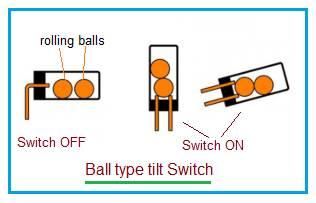Tilt Switch and Sensor: Advantages and Disadvantages
Advertisement
This page explores the advantages and disadvantages of tilt switches and tilt sensors.
Introduction
- Both tilt switches and tilt sensors serve the same function: to detect tilt or inclination. They become ON or OFF based on the degree of tilt.
- A tilt switch is an electromechanical switch, while a tilt sensor is an electronic device.
- Tilt sensors are classified as single axis/single output, dual axis/dual output, and dual axis/single output.
- Most tilt switches are SPST (Single Pole Single Throw) type, either normally open or normally closed.
- Mercury-based tilt switches are the oldest type, utilizing mercury’s excellent electrical conductivity. These switches use a blob of mercury in a glass bulb. When the bulb is tilted, the mercury makes contact with two leads, allowing current to flow when the switch is connected in series with a battery.
- Due to environmental hazards and regulations, mercury-based tilt switches are increasingly replaced by ball-type tilt switches or tilt sensors.


Figure 1 depicts both mercury-type and ball-type tilt switches. The advantages and disadvantages vary depending on the specific type of tilt switch or sensor.
Benefits/Advantages of Tilt Switches/Sensors
The following are the benefits and advantages of tilt switches and tilt sensors:
- Mercury-based tilt switch:
- Low cost and easy to use.
- Very long operating life.
- Low resistance and quiet operation.
- Ball-type tilt switch:
- Offers multiple contacts, allowing determination of tilt direction.
- Less toxic compared to mercury switches.
- General Advantages:
- Very small in size.
- Consume low power.
- Durable when used properly.
- Easy to interface with microcontrollers for various analyses with simple code.
Drawbacks/Disadvantages of Tilt Switches/Sensors
The following are the drawbacks and disadvantages of tilt switches and tilt sensors:
- Mercury-based tilt switch:
- Mercury is hazardous due to its toxicity.
- Ball-type tilt switch:
- Arcing may erode the contacts when the switch is subjected to current above its rated specification, reducing reliability.
- Vibration of the balls can create erratic or random signals.
- General Disadvantages:
- Require gravity to operate (to roll a ball or move a blob of mercury). Therefore, they will not work under low gravity, reversed gravity, or zero gravity conditions.
- Performance in vehicles that accelerate or decelerate suddenly may be unreliable.
- Deliver erroneous results under significant vibration conditions.
 RF
RF

